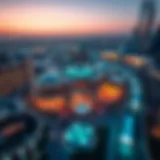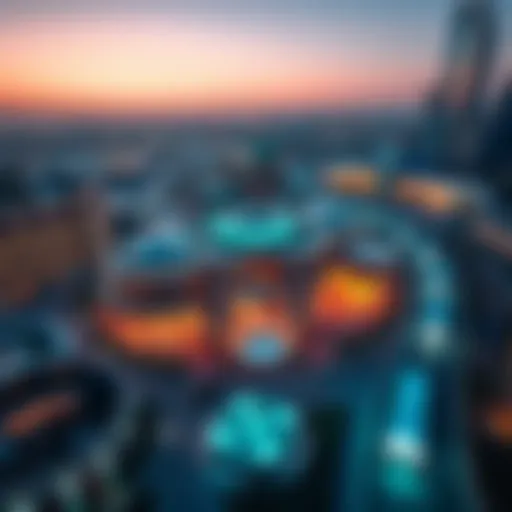Exploring The Green Planet in Dubai's Luxury Real Estate


Intro
In the heart of Dubai, a striking blend of artistry and nature emerges, encapsulating The Green Planet. This biodome stands not merely as a testament to architectural creativity, but also reflects the city’s commitment to sustainability and luxury living. Understanding this innovative space is essential for investors and homeowners keen on Dubai's thriving real estate market. It offers a vivid narrative that intertwines the grace of nature within the concrete jungle, marking a turning point in luxury property dynamics.
Investors eye this unique attraction not just for its aesthetic allure but for its potential impact on property values in the surrounding area. With a growing number of buyers looking for properties that promise proximity to green spaces and leisure spots, The Green Planet certainly fits the bill as a major influence in shaping the luxury segment of Dubai's market. This article will explore various facets of this biodome, shedding light on its architectural marvels, environmental initiatives, and the implications for property investments.
As we delve into this captivating oasis, you'll gain valuable insights into the market trends and investment strategies associated with luxury properties in Dubai. Whether you are a seasoned investor or a first-time buyer, understanding the significance of The Green Planet will help tailor your decisions in navigating the real estate landscape effectively.
Prolusion to The Green Planet
The Green Planet in Dubai emerges not simply as a structure, but as a thoughtful integration of luxury and nature. It signifies a sophisticated blend of architectural ingenuity and environmental responsibility, offering a sanctuary amid the urban sprawl. This biodome serves as a necessary counterbalance to the rapid urbanization of Dubai, making its exploration essential for understanding the future of urban landscapes.
Concept and Design
The concept behind The Green Planet is inspired by the natural ecosystems found worldwide. It offers visitors a glimpse of exotic plants and wildlife, all housed under one roof. By creating a micro-ecosystem, the design prioritizes not only aesthetic appeal but also ecological education. The aim is to enrich public understanding of biodiversity and sustainability, which is paramount in today's world where climate change is an ever-pressing concern.
- Integration of Nature and Urban Life: Located in a bustling area, The Green Planet is a testament to the idea that urban living does not have to exclude nature. The design incorporates lush vegetation, interconnected ecosystems, and a climate-controlled environment, allowing for an immersive experience.
- Sustainability Features: The layout includes innovative solutions to reduce carbon footprints, such as energy-efficient lighting and built-in water treatment systems that mirror natural processes, hence fostering an environment conducive to life.
This concept ultimately seeks to bridge the gap that urban development often creates between humanity and the natural environment.
Architectural Features
The architectural design of The Green Planet is as captivating as its purpose. Crafted by some of the industry's leading architects, the biodome boasts several notable features:
- Large Dome Structure: The facility's striking dome is not just visually appealing; it also allows for maximum sunlight to penetrate, promoting plant growth while minimizing energy consumption for lighting.
- Natural Climate Control: Inside, visitors experience a climate reminiscent of a rainforest, thanks to a carefully designed humidity and temperature control system that mimics the conditions needed for tropical flora and fauna.
- Interactive Elements: The layout includes various interactive displays, enhancing visitor engagement. From educational signage to live demonstrations, the experience is designed to be informative and inspiring.
"The Green Planet stands as an exemplar of how urban spaces can prioritize ecological integrity without sacrificing luxury."
In summary, The Green Planet is not merely an attraction; it's a visionary space redefining what luxury can mean in urban contexts. Understanding its concept and architectural features is key for anyone interested in the future of real estate in Dubai, especially as more developments aim for sustainability and integration with nature.
The Significance of Green Spaces in Urban Development
Green spaces in urban settings play a crucial role that extends beyond mere aesthetics. In the context of a luxury oasis like The Green Planet in Dubai, such spaces are pivotal. They influence not only environmental quality but also the overall well-being of residents and visitors. As urbanization continues at a breakneck speed, integrating green spaces becomes not just beneficial but necessary for sustainable urban development.
Enhancing Environmental Quality
The presence of greenery in urban areas significantly enhances environmental quality. First and foremost, plants and trees act as natural air filters, absorbing pollutants and releasing oxygen. This results in a healthier atmosphere, which is critical for the high-density living often seen in cities. For instance, The Green Planet showcases a unique ecosystem that not only supports a variety of plant and animal life but also improves air quality for the surrounding community.
Moreover, such spaces help in regulating temperature through shade and evapotranspiration. In a hot climate like Dubai’s, shaded areas provided by green parks can drastically lower the temperatures, leading to a more pleasant outdoor experience. Facilities that include these green spaces often draw in higher levels of engagement from the community, promoting outdoor activities, relaxation, and an overall improved quality of life.
Another essential aspect is stormwater management. Green areas are more permeable compared to concrete and asphalt, allowing rainwater to absorb into the soil. This reduces runoff, minimizing flooding risks—a growing concern in urban environments worldwide. The Green Planet not only serves as an educational hub but also acts as a model for other developments by showcasing sustainable practices in stormwater management.
Promoting Biodiversity
Promoting biodiversity is another crucial element of green spaces in urban urban developments. Urbanization often leads to habitat destruction, reducing the vitality of various species. However, spaces that incorporate diverse ecosystems—like The Green Planet—can turn this trend on its head. By hosting a variety of flora and fauna, such biodomes offer sanctuary to countless species, thus enriching the ecological fabric of the city.
The careful selection of species at The Green Planet not only aims at aesthetic appeal but importantly fulfills ecological roles that foster a balanced environment. Creating habitats for pollinators, such as bees and butterflies, can significantly benefit urban ecosystems. This aspect, often overlooked, has far-reaching implications for food production and overall ecosystem health.
In addition, these green refuges offer educational opportunities for tourists and locals alike. Programs and exhibits that highlight the importance of conservation and biodiversity can lead to greater public awareness, ultimately promoting a culture of sustainability within the broader community. This, in turn, fosters a collective responsibility towards protecting the environment, demonstrating how urban spaces can simultaneously support human needs and biodiversity.


The integration of green spaces in urban planning is not just about making cities look pretty; it’s about nurturing life, fostering community connections, and ensuring sustainable futures.
As investors and developers consider the implications of projects near green spaces like The Green Planet, there’s clear evidence showing that these features can substantially enhance the market appeal of property. Spaces that prioritize nature create a unique selling proposition and can lead to long-term investment value.
Sustainability Initiatives at The Green Planet
Sustainability is not just a buzzword; it's a necessity in the modern world, especially in urban locales like Dubai. The Green Planet embodies a commitment to balancing luxury life with environmental consciousness. This biodome serves as a pioneering model of how sustainability can harmoniously coexist with urban development, offering a wealth of lessons for investors, developers, and city planners.
The Green Planet stands out as an innovative answer to the pressing need for environmental stewardship in cities. Key sustainability initiatives implemented here not only aim to reduce the ecological footprint but also enhance the overall living experience within the metropolis.
Energy Efficiency Measures
At the core of The Green Planet's sustainability framework are rigorous energy efficiency measures aimed at reducing energy consumption and maximizing resources. The biodome operates under smart building technologies to optimize energy use, which includes:
- LED Lighting: The entire facility is equipped with energy-efficient LED lights, which significantly lower energy costs compared to traditional lighting.
- Solar Panels: Installed on the roof, solar panels harness the sun's energy, enabling The Green Planet to partially power its amenities through renewable resources.
- Automated Climate Control: Advanced systems ensure that the internal temperatures remain stable, reducing the need for excessive air conditioning, a consideration that resonates significantly in Dubai’s climate.
These energy measures not only lower operational costs but also position The Green Planet as a forward-thinking destination for eco-conscious investors looking for properties with lower utility overheads. In a market where energy efficiency increasingly impacts property values, embracing such technologies adds significant allure.
Water Conservation Strategies
Water scarcity presents a pressing challenge in arid regions like the Middle East. At The Green Planet, innovative water conservation strategies play a crucial role in promoting sustainability. These strategies involve:
- Rainwater Harvesting: The biodome incorporates systems designed to collect and utilize rainwater for irrigation and other non-potable purposes, effectively reducing dependency on the municipal water supply.
- Drip Irrigation Systems: Installed throughout the facility's wide array of plant life, this method minimizes water usage while ensuring that plants receive necessary hydration.
- Greywater Recycling: Water from sinks and other facilities is treated and reused for landscape irrigation, demonstrating an efficient circular approach to water management.
The application of these water conservation techniques not only underscores a commitment to responsible water use but also enhances the lifestyle amenities offered in the surrounding residential areas. Investors looking to understand the long-term viability of properties in proximity to The Green Planet should recognize the added value these practices bring to the community.
The Green Planet is more than an architectural marvel; it is a testament to what can be achieved when sustainability takes center stage in urban planning. As stakeholders in real estate, from homeowners to developers, take note of these initiatives, they should consider the broader implications of such projects on investment opportunities and community welfare.
"Sustainability isn’t just an option for the future; it’s the only way to ensure our cities thrive in harmony with nature."
In a nutshell, the sustainability initiatives undertaken at The Green Planet are not merely decorative but foundational, aiming to create a resilient urban ecosystem that benefits residents and investors alike.
Real Estate Implications of The Green Planet's Proximity
The integration of The Green Planet into Dubai's landscape has profound effects on the surrounding real estate market. This biodome does not merely serve as a visual marvel; it plays a crucial role in shaping the dynamics of property values and investment trends in the area. As we delve deeper, it becomes clear that living close to such a unique attraction offers numerous benefits, steering potential homeowners and investors towards lucrative decisions.
Property Values Around The Green Planet
The presence of The Green Planet has notably elevated property values in its vicinity. Homebuyers and investors are keenly aware that properties near such an environmental gem are often viewed as more desirable. This boost can be attributed to several factors:
- Desirability: Proximity to green space typically correlates with higher property demand. Buyers are often willing to pay a premium for residences that promise a blend of urban convenience and natural tranquility.
- Amenities: Properties in this area offer access to recreational activities, educational exhibits, and a community atmosphere, making them attractive for families and professionals alike.
- Market Trends: Analytics show that areas around The Green Planet have recorded sizable appreciation in property values, a trend that investors should note. This growing popularity can lead to long-term gains for those who invest in real estate near the biodome.
"Properties within a stone's throw of The Green Planet are not just buildings; they represent an investment in a lifestyle that’s increasingly sought after in urban environments."
Luxury Living and Investment Opportunities
The luxury real estate segment near The Green Planet is thriving, presenting a cornucopia of investment opportunities. Developers recognize the potential of this location, crafting residences that not only cater to the high-end market but also embody sustainability and modern living.
- High-End Developments: Several new projects are underway that focus on luxury living entwined with nature. These developments often feature:
- Rental Market: The rental market is equally buoyant, with many high-income renters drawn to the allure of living near a biodome. Whether for professionals seeking a vibrant lifestyle or expatriates wanting a touch of nature in their urban experience, demand continues to rise.
- Long-term Visions: Investors eyeing Dubai's real estate landscape will find the area surrounding The Green Planet an enticing prospect. As sustainability becomes a focal point of urban development, properties near such initiatives are likely to command attention and premium prices in the future.
- Eco-friendly designs
- Smart home technologies
- Concierge services and extensive amenities.


Investing near The Green Planet means being part of a narrative that combines luxury, community, and ecological foresight.
The Role of The Green Planet in Community Development
The Green Planet stands as a beacon of modern urbanity meshed with nature. It provides more than just a lush retreat in the heart of Dubai; it plays a fundamental role in fostering community development. With its intricate design, it offers a place for people to connect, immerse themselves in nature, and enjoy various lifestyle amenities that enhance their quality of life. This section explores how The Green Planet contributes to shaping the community and serving the greater goals of urban living.
Fostering a Sense of Place
In recent years, the idea of a "sense of place" has become pivotal for urban areas striving to create inclusive environments. The Green Planet does just that by bringing together individuals from diverse backgrounds under one roof. It promotes not just biodiversity but social connectivity among its visitors. The immersive experience of walking through lush foliage, observing exotic wildlife, and participating in educational programs creates a unique atmosphere that fosters community ties.
- The design invites both residents and tourists, encouraging interaction and the sharing of ideas.
- Various events hosted at The Green Planet often highlight local culture and ecological awareness, reinforcing its status as a communal hub.
- Moreover, as a landmark, it helps build local pride and identity, making those who live nearby more likely to invest in their community.
By rooting the community in a shared experience with nature, The Green Planet transforms a simple visit into a profound connection to the environment and each other.
Enhancing Lifestyle Amenities
The presence of The Green Planet significantly enhances the lifestyle offerings available to its surrounding neighborhoods. When looking at the overall development, amenities play a key role in enticing investors and buyers. In fact, the biodome has catalyzed a shift in the perception of luxury living in Dubai. Residents now have access to outdoor recreational options that were sparse before.
- Immersive Experiences: The various zones within the biodome are designed to be educational and entertaining. From tropical rainforests to unique animal encounters, it caters to a broad audience.
- Health and Wellness: Natural elements proven to enhance mental well-being are plentiful. As such, it not only serves as a place of recreation but also promotes a healthier lifestyle.
- Convenience: Its proximity to various dining and shopping establishments provides easy access to food, goods, and services, improving day-to-day living.
Overall, the array of offerings transforms the area into a desirable locale for homebuyers, making the presence of The Green Planet a beneficial anchor amidst the urban sprawl.
The Green Planet has become a pivotal player in transforming Dubai's community landscape, linking nature, lifestyle, and social interaction in a cohesive manner.
Challenges and Criticisms
While The Green Planet in Dubai stands as a testimony to the city's ambitions of blending luxury with sustainability, it is not without its share of challenges and criticisms. Understanding these aspects is essential as it shapes the conversation around urban development, sustainability, and demographic dynamics in a rapidly changing environment.
Sustainability vs. Urbanization
The clash between sustainability and urbanization is like a tug-of-war where both sides have valid claims. On one hand, The Green Planet promotes an image of eco-friendliness and biodiversity, presenting a green sanctuary amid the hustle and bustle of a city that often seems in a race against nature. It aims to achieve sustainability by minimizing carbon footprints while educating the public about environmental stewardship. Yet, there are concerns that such an oasis could serve as a façade, masking the more damaging impacts of rapid urbanization prevalent across Dubai.
- Development Pressure: As urban expansion continues, natural landscapes are frequently sacrificed. There's an ongoing debate whether projects like The Green Planet genuinely contribute to ecological balance or simply placate the growing urban sprawl without addressing the root problems.
- Social Implications: Critics argue that while wealthy residents of Dubai enjoy the luxury of a biodome, lower-income citizens might not benefit from these green initiatives. The stark socio-economic divide raises questions about who truly gains from Dubai’s urban landscape developments.
Moreover, maintaining the delicate ecosystem within The Green Planet requires continuous input of resources, including water and energy. Critics point out that if not managed carefully, efforts to sustain this manageable ecosystem could inadvertently exacerbate resource depletion elsewhere in the city.
Balancing Growth and Preservation
Finding equilibrium between growth and preservation is likened to walking a tightrope. The Green Planet illustrates this balance quite vividly. On one side lies the necessity to foster economic growth through tourism and real estate development. On the other is the imperative to preserve cultural and environmental heritage, ensuring that future generations can appreciate the beauty of its unique biodiversity.
- Cultural Significance: Maintaining local flora and fauna is crucial not only for biodiversity but also for cultural identity. Urban projects can overshadow traditional cultural practices and spaces, leading to a homogenized culture that lacks the unique flavors of the local traditions.
- Ecological Integrity: Growth demands land, often at the expense of natural habitats. The Green Planet seeks to counteract this by providing a biophilic environment, but success in conservation often depends on the commitment of surrounding developments to prioritize ecological principles.
"Effective urban planning must integrate sustainable practices, balancing development needs with ecological preservation to craft a future where both can thrive together."
Navigating these challenges is crucial, especially for investors, realtors, and developers, all of whom should consider the long-term implications of their involvement in such intertwined dynamics.
Comparative Analysis with Other Green Initiatives
The comparison of The Green Planet with other urban green initiatives provides deeper insights into its significance within the context of Dubai's luxury ecosystem. By examining how similar projects across the globe handle sustainability, biodiversity, and real estate development, we can carve out a nuanced understanding of the challenges and triumphs that define urban biodomes. This evaluation also helps in identifying best practices which can serve to refine future developments in Dubai and beyond.


Global Examples of Urban Biodomes
Cities around the world are recognizing the need for green spaces amid rapid urbanization. Notable examples of urban biodomes include:
- The Eden Project in Cornwall, UK: This project features massive biomes that house diverse plant species and education facilities. Not only is it an environmental initiative, but it also serves as a hub for eco-tourism and educational programs, boosting the local economy significantly.
- Bosco Verticale in Milan, Italy: Translating to "Vertical Forest," this residential project integrates a tremendous amount of greenery directly into its architecture. Each skyscraper has thousands of trees and plants, significantly improving air quality while providing residents with a unique living experience.
- The H Butterfly in Shenzhen, China: This project is centered around a vast urban park within a high-rise development. It's designed to encourage biodiversity while offering a communal space, blending nature with urban life seamlessly.
These global examples showcase diverse methodologies for incorporating greenery into urban settings. Each insists on accountability to the environment and community, making them noteworthy in comparison to The Green Planet. In that way, investors and developers in Dubai can take cues from the successes and challenges faced by these initiatives.
Lessons Learned and Future Directions
The exploration of international urban biodomes reveals several valuable lessons applicable to Dubai's vision for The Green Planet:
- Community Engagement: Initiatives that involve local communities in the planning and maintenance phases tend to thrive longer. Feedback from residents and businesses creates a sense of ownership that fosters sustainability.
- Diversity in Native Species: Focusing on species which thrive naturally in the local environment enhances the ecosystem's resiliency. This practice could be an avenue for The Green Planet to consider, encouraging local flora and fauna instead of exotic, non-native species.
- Multi-Use Spaces: Projects like the Eden Project serve multiple purposes, combining entertainment with education, and environmental advocacy with tourism. Future directions for The Green Planet could involve expanding its offerings to include more educational programs and facilities that cater to both residents and visitors.
- Technological Integration: Utilizing smart technology for monitoring environmental conditions and plant health can optimize resource use. This will help maintain the biodome effectively while reducing the carbon footprint.
In summary, as Dubai continues to develop its green vision, the lessons gleaned from these global examples can sculpt a more sophisticated understanding of sustainable practices. This comprehensive analysis contributes not only to the allure of luxury living but also emphasizes the need for ecological balance.
Future Developments in the Area
The changing skyline of Dubai is a testament to its relentless pursuit of innovation. In recent years, green initiatives have gained significant traction, intertwined with the luxury real estate narrative. The focus on future developments around The Green Planet not only enhances the visual and experiential appeal of the area but also contributes to broader goals of sustainability and community well-being.
Potential Real Estate Projects
As Dubai continues to evolve, the potential for new real estate projects around The Green Planet is both exciting and promising. The lush ecosystem created by the biodome has laid down a framework that will serve as an anchor for upcoming high-end residential and commercial properties. Here are some possibilities:
- Eco-Friendly Residential Complexes: Developers may look to integrate eco-friendly designs that echo the principles of The Green Planet, featuring green roofs, living walls, and shared gardens. Such amenities could attract environmentally conscious buyers looking for luxury housing options.
- Mixed-Use Developments: There’s a trend towards creating spaces that combine living, working, and leisure. This not only meets the demand for convenience but also promotes community interaction, enhancing the overall livability of the area.
- Cultural and Educational Centers: Projects aiming to educate residents and tourists about sustainability and conservation could emerge, aligning with Dubai's vision to create a culturally rich and environmentally responsible city.
These projects will likely enhance property values and appeal to a diverse range of stakeholders, from investors to future homeowners. The synergy between luxury living and ecological responsibility is an equation that many developers will aim to solve in the coming years.
Long-Term Vision for Sustainability
Looking ahead, sustainability is not just a buzzword for the future developments surrounding The Green Planet, but a necessity. Dubai has set ambitious targets that stress ecological balance and resource management. Here are some strategic directions:
- Adopting Green Building Practices: Future developments will likely adhere to rigorous standards of sustainability. This includes using sustainable materials, maximizing energy efficiency, and optimizing water usage. Considerations like LEED (Leadership in Energy and Environmental Design) certification will become increasingly common.
- Integrating Renewable Energy Sources: Solar panels and wind turbines may become standard features in new projects, reducing reliance on fossil fuels and promoting cleaner energy.
- Enhancing Connectivity to Public Transport: A vision of sustainability involves minimizing traffic congestion and lowering carbon emissions, achieved through improved public transport links. Developers may prioritize proximity to transport stations to facilitate better access.
"Incorporating sustainable practices is not just good for the environment; it's also a smart business move in today's market."
- Implementing Water Management Strategies: Given Dubai's arid climate, water conservation practices, including greywater recycling and drought-resistant landscaping, will play a critical role in future developments.
By addressing these key areas, developers can contribute not only to the economic fabric of Dubai but also to a viable environmental future. Investors and homebuyers alike will find significant value in properties that honor this sustainable vision, aligned with global trends towards more responsible living.
In summary, the landscape surrounding The Green Planet is ripe for development that harmonizes luxury and sustainable living. The future beckons with promise, extending a welcome mat to discerning buyers and stakeholders eager to be part of this extraordinary journey.
Finale
The conclusion of this exploration into The Green Planet in Dubai holds substantial importance as it ties together the various threads of insight gathered throughout the article. It serves not just as a summary but as a crystallization of the key themes that define the extraordinary impact of this biodome on both the environment and the luxury real estate sector in Dubai.
Summary of Insights Gained
The examination has shed light on several vital points:
- Architectural Marvel: The Green Planet draws attention not only for its unique biophilic design but also for how it integrates natural elements within an urban setting. Such thoughtful design is a prototype for future projects aiming for similar harmony.
- Environmental Contributions: By promoting biodiversity and improved air quality, The Green Planet is pivotal in enhancing urban living. This aligns with global sustainability goals and positions Dubai as a leader in innovative green urban initiatives.
- Real Estate Dynamics: Properties in proximity to The Green Planet witness positive shifts in market value, attributed to the allure of luxury combined with environmental consciousness. Buyers and investors are increasingly looking for green features when assessing property, making this biodome a valuable asset.
- Community Impact: The Green Planet fosters a sense of community through its educational and recreational offerings, reinforcing the idea that urban spaces can be both luxurious and nurturing.
Implications for Future Investments
There are significant implications for those considering investments in the vicinity of The Green Planet:
- Value Appreciation: With the rising trend in sustainable living, properties near this biodome are expected to appreciate over time. Investors should be mindful of the increasing demand for eco-friendly developments and consider this in their portfolios.
- Shift Towards Sustainable Amenities: Expect developers to focus more on green spaces and sustainability features in their projects, changing the landscape of luxury real estate. This trend indicates a demand for environments that enhance well-being, a crucial factor for modern buyers.
- Market Positioning: Investors are encouraged to position themselves in ways that align with these emerging market dynamics. By understanding the growing importance of sustainability, real estate professionals can better inform their clients and adjust investment strategies accordingly.









